If you are looking for a hobby that combines fun and physical activity, ice skating is a good choice.
No idea how to go about it? We’ve got you covered. Here’s all you need to know about ice skating as a hobby.
What’s Ice Skating?
Ice skating is a hobby or sport where you glide on the ice. Well, the skates cut into the ice – but not to bog you down with technical details -we’ll call it gliding.
You can ice skate outdoors on natural ice or in an indoor ice rink. Ice skating covers a whole host of different skating types, so it can mean anything from figure skating to dancing on ice.
How is it different from roller skating? For starters, the types of skates you use and where you do it.
Ice skating, as the name suggests, can only happen on the ice and not anywhere else.
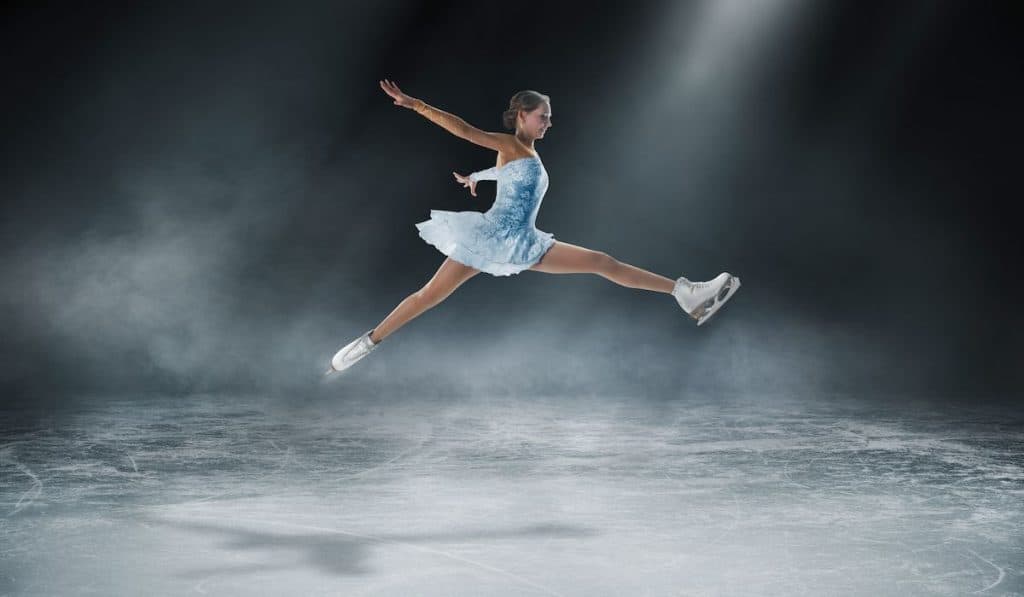
Types of Ice Skating
Ice skating is a generic term that covers all the activities you can do on ice while wearing skates.
It includes many different categories of ice sports. Here are some ice-skating activities you can do.
Figure skating
With figure skating, one gets to display some moves on the ice. It typically involves twists, turns, and jumps that display balance and skill.
You can do it as an individual, in pairs, or groups. At the Olympics, people take turns to wow the judges with their skating moves to score points.
Ice dancing
This one is a variant of figure skating. But instead of making individual moves, you do a whole dance routine on the ice.
Tour skating
If you love traveling, this one will do you lots of good. It involves traveling around the world to skate on natural ice in various locations.
You get to explore the world. You will also enjoy exploring the beauty of nature while testing out nature’s ice rinks.
Ice hockey
This one entails adding hockey to skating. You have to balance on the skates and still be able to hit the puck with the hockey sticks. The game is played in teams of two, similar to soccer, the idea of the game is to get the puck into the opposition’s goal.
Speed skating
Do you find speed thrilling? Yes? You will love speed skating. Speed skating involves racing on the ice. It’s a speed chase to see who gets to the finish line first.
Now that we know what’s involved, let’s see how you can benefit from ice skating.
What Makes Ice Skating A Great Hobby?
Versatile hobby
Ice skating comes in many different varieties, with plenty to do on the ice. From ice dancing, figure skating to ice hockey, there’s lots to do on skates.
You can switch it up as often as you want. Moreover, if sports are not your thing, you can just play on the ice – no rules.
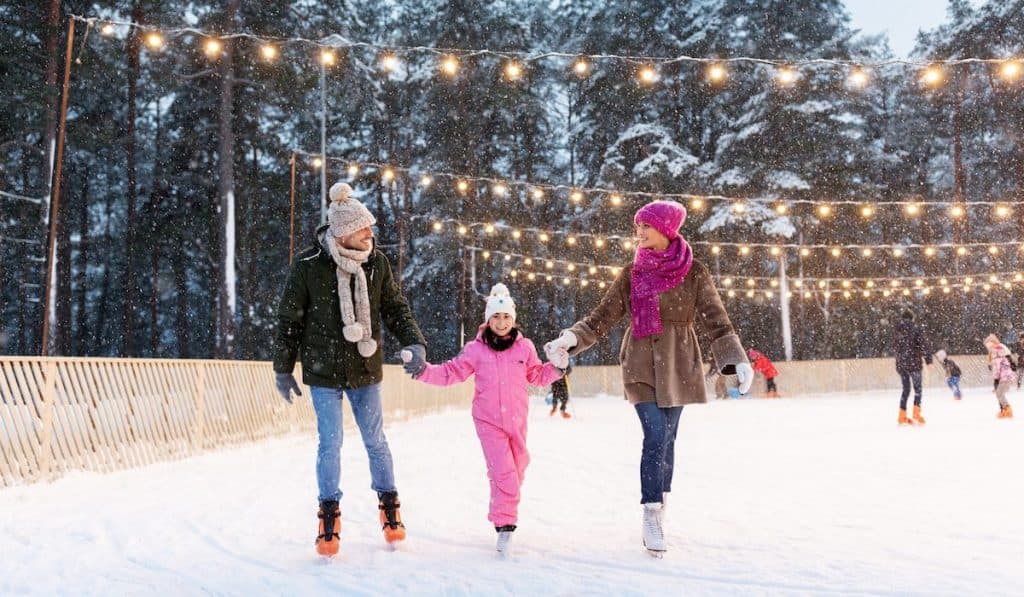
Family fun
There’s no age restriction when it comes to ice skating. It’s perfect for the whole family.
It’s a great way to introduce some new family fun activities. Even grandma and grandpa can join in. You can use it as a family bonding tool.
We all know how easily kids can get bored. With ice skating, you’ll never have to worry about that.
You can try many different things, and it will be like something new all the time.
Keeping fit
Ice skating involves a lot of physical activity. It’s a great way to keep in shape. It will help you maintain or lose some weight.
What’s more, you get to stay active all while having fun. It’s a win-win whichever way you look at it.
According to Health Fitness Revolution, the body can lose up to 650 calories on the ice. If you opt for speed skating, you can lose even more.
What’s more, your body has to keep your core temperature high enough on the ice.
That makes it work much harder, helping you burn some weight off.
Great for your mind
Mental stimulation is another benefit of ice skating.
Mastering all the different moves will energize brain activity, especially in small children whose brain is still forming connections.
Adults can also benefit from this mental stimulation.
How?
Keeping your brain active and engaged will help to lessen problems like memory loss in old age.
That’s why you can start ice skating at any age and still benefit from some mental exercise.
Strong muscles
Spending time in a crouching position on the rink helps strengthen your core. Not only that, but it also helps with your thigh muscles.
Also, most skating involves considerable use of your hands as well, so you get to work out all your muscles at once.
You will get a toned body with great muscle strength. On top of that, it will boost your endurance levels significantly.
Improves balance
Learning how to coordinate while gliding on skates will teach your body to find its center—therefore, skating on ice helps improve your balance.
That way, you won’t topple over all the time. Once you master the art of staying up, you improve your overall balance.
How to Get Started
Now it’s time to figure out where to start. Here’s what you need to know about creating an ice-skating hobby.
Where do I Learn How to Ice Skate?
Unless you have an ice rink at home (which you can make), you won’t be able to do it at home.
You have to go to an ice rink to learn. As a beginner, you may want to start by going to a public ice rink where you can start practicing how to go about it.

Once you decide which type of ice-skating appeals to you the most, choose an ice rink where they specialize in that type of skating.
The ice rink you pick will depend on your age and whether it offers training for beginner skaters.
The Learn to Skate USA curriculum has loads of training options for beginners and advanced skaters. Their curriculum covers both kids and adults.
Once you get in touch with them, they’ll point you in the direction of a rink and an instructor.
If you prefer self-teaching, grab a few books and watch some training videos on YouTube to learn a couple of techniques.
You are not going to learn anything by watching, though. You need to go out and practice the moves.
As an absolute beginner, try out a few styles before you commit. To help you make your decision, hop around a little bit.
Go to the ice hockey rink or a figure skating place and just watch for a day or two.
Once you figure out what the others are doing, give it a go. Most places will have some skates for you to rent for the day.
Therefore, take advantage of this and find your footing first. You will only have to commit once you decide what works for you.
If getting into the sport doesn’t interest you, stick to the free for all ice rink and rent out some skates to start with.
You can buy your pair once you fall in love with the hobby (which you will).
Learning to Skate
We won’t sugarcoat it; there’s going to be a bit of falling when you start.
But don’t worry, it will be fun laughing at yourself (or your partner) when you fall.
Here are a few tips to make the learning process faster so you can quickly get your balance.
Walk first
Before you get out on the rink, learn to walk on your skates first.
Most places have some rubber mats to practice walking on skates.
Use your skates to walk on the rubber matting first until you get the gist of balancing.
Go on the rink
Once you get the hang of the walk, it’s time to get on the ice. You will be very shaky at first.
So, you can try holding on to the walls/barriers of the rink as you learn how to do it.
Occasionally let go of the wall/barrier and practice your balancing posture.
Slightly crouched knees bent, and arms stretched out in front of you. Try this for a few intervals at a time, going back to the wall whenever you need to.
You’ll want to stay close to the wall at this stage just in case you need something to grab on.
Keep at it until you get the hang of it. It won’t be glamourous or graceful, but you’ll learn faster. Once you do, you’ll be gliding gracefully in no time.
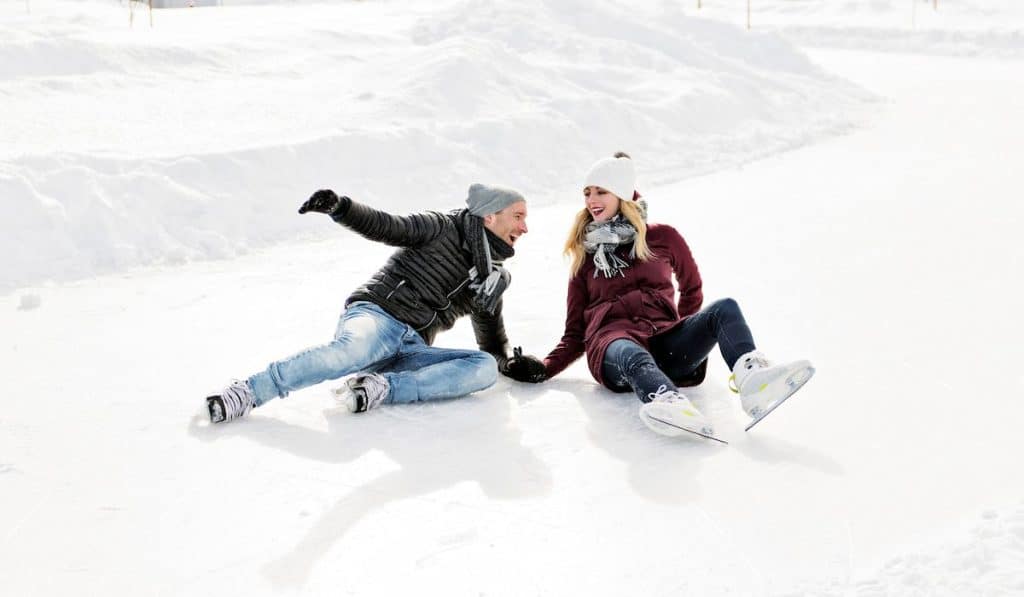
Brace for the fall
Again, it’s okay to fall; that’s just a part of the ice-skating learning fun. Just remember, though, to try and fall sideways so you won’t get hurt.
If you feel you are about to fall, lower your center of gravity. That simply means crouch, so you are as close to the ice as possible to reduce impact.
Thus, you won’t fall on your face or knees, which may be somewhat painful.
For the first couple of times at the rink, put on safety paddings like knee or elbow pads to soften your falls.
Once you get the hang of it, you’ll be wondering how you ever fell.
It’s also important to remember not to try and break the fall with your hands, or you’ll get hurt.
When you fall, it helps to kneel on the ground with all fours and then gently lift yourself.
This way, you won’t put too much pressure on your back.
Get up quickly when you fall, too, so you don’t get bumped into by other skaters.
Ice Skating Gear
You will need a pair of skates and some comfortable clothes. Once you have this, you are good to go.
To get the most out of your ice-skating hobby, you will need to make sure you have the right skates.
Here’s what you need to know about getting your skates.
Getting the Right Skates
As a newbie skater, you want to start with rental skates. Why? Because it will save you some money if you decide, ice skating is not for you.
However, if you’ve already made up your mind, you can buy your skates from the get-go.
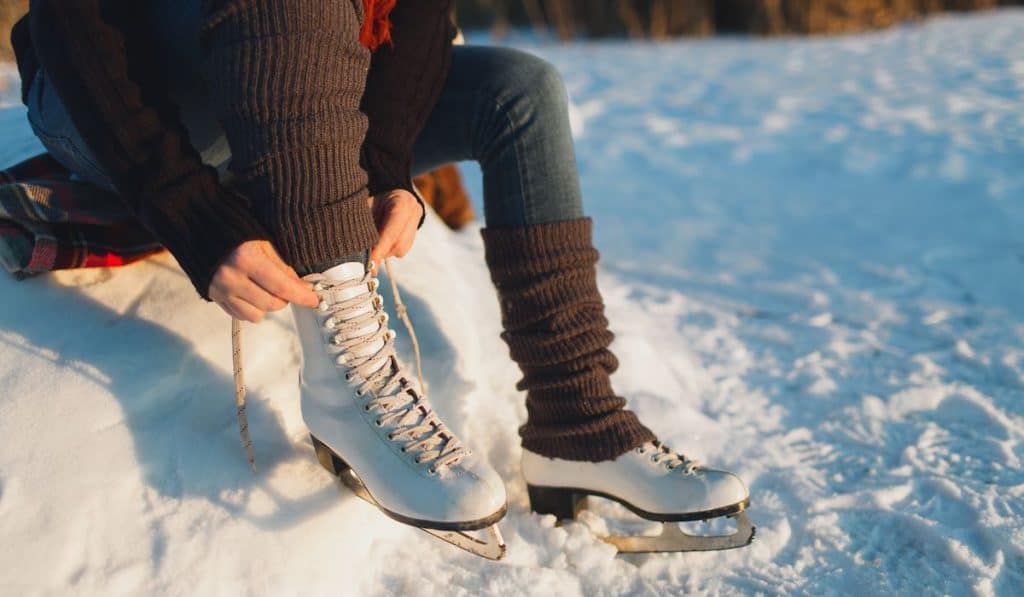
Type of skates
Skates will look very different depending on the type of ice skating.
For example, speed skates have a very long blade, while figure skates have a shorter blade under the boot.
Before making a purchase, you need to decide which type of ice skating you are going for.
If you get the wrong set of skates, they make it very difficult for you to learn. It will also be unsafe for others on the rink.
Therefore, do some research and ask the salespeople which one works for you for the skating you are interested in.
Perfect fit
It’s not a good idea to buy skates before you try them on. That’s because you have to make sure your skates fit your feet perfectly.
If they are too big or too small, you won’t be able to find your balance. They could also give you blisters; then you’ll hate them so much you end up quitting.
Thus, to avoid getting the worst of it, make sure to get a perfect fit.
If you are buying skates for the kids, avoid buying a larger size so they’ll “grow into them”.
It will make the skating experience horrible for your kids, and they won’t learn how to balance correctly.
Apart from being a perfect fit, they should feel padded enough.
Using worn-out skates will make it uncomfortable when you are trying to maintain balance.
Also, check how they feel around your ankle area. The skates should give support and, at the same time, not feel too tight.
If you are using rental skates, put on a pair of extra thick socks to get some additional padding.
What Should I Wear for Ice Skating?
Hold off on buying those fancy (but cute) figure skating outfits. As a beginner, there’s no need to look competition worthy.
Be sure to wear warm clothes and find the right balance between warm and comfortable.
Here are some tips for getting dressed for skating.
Gloves
It will be easier to balance on the ice if you can use your hands freely. That’s why you need a warm pair of gloves to keep your hands from freezing.
But it’s not a good idea to just pull out your pair of old gloves.
Why? Because you need water-resistant and padded gloves on the ice.
Your gloves also have to allow a firm grip so you can get up quickly when you fall. It helps if the gloves have an extra lining for added warmth.
Long Pants
You will need a pair of long pants to keep warm and dry. Make sure your pants are comfortable enough to let you move freely, not too tight.
Jeans are a no-no on the rink. They will make it difficult for you to move.
On top of that, they stay wet for longer, meaning you will feel cold, and you’ll have a more challenging time getting up when you fall.
Helmet
As a newbie ice skater, to avoid nasty falls, it helps to wear a safety helmet. Make sure your helmet is a good fit. Not too small or too big.
It shouldn’t cover your eyes, leave some parts of your head out, or cover the back of your neck. If it doesn’t fit perfectly, you risk injuring yourself.
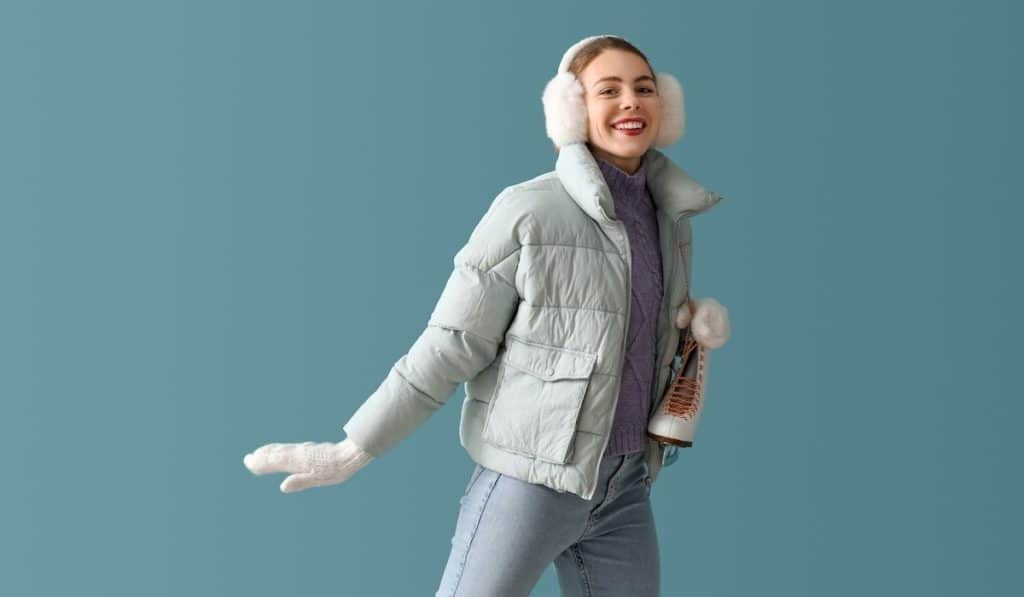
Jacket
You won’t enjoy ice skating if you are cold. That’s why you should wear a jacket to cover up.
But not any odd jacket will do, you need a good jacket that’s warm but light enough for you to glide.
Avoid jackets with strings or extensions. It won’t be very nice if a string gets caught up in the blades.
Warm hat or beanie
It’s a good idea to wear a warm hat or beanie to cover your head and your ears.
That way, you’ll be warm and cozy and enjoy your skating experience.
Plus, it will protect your hair if it’s long, so it doesn’t get caught up when you fall or get wet.
Socks
A good pair of socks can make the difference between a comfortable skate and blistered feet. Buy a couple of good fit socks that allow your skates to fit perfectly.
How Long Does It Take to Learn Ice Skating?
It can take anything from a few hours to months, depending on how athletic you are and how many hours you practice.
If you’ve ever skied before, it should take you less time to learn.
That said, one of the biggest reasons why some people take longer to learn is fear.
That’s why it won’t take you too long to become competent at skating if you overcome the fear of falling.
To get to the Olympic level usually takes years of practice. If you are going to the rink just for some fun, you should learn how to balance in a couple of days.
Is Ice Skating Dangerous?
No, not at all; with the right safety precautions, there’s nothing to worry about. Nasty falls are not common on the ice.
Before you learn to get your balance on the ice, wear safety padding and helmets to protect yourself when you fall.
Once you are pro, you can decide whether you want to put on the padding still or not.
As a general rule, you will need to put on helmets and padding all the time for ice hockey. That’s because ice hockey is a bit more aggressive, and you must stay protected.
Make sure your helmet is a good fit. Not too small or too big. It shouldn’t cover your eyes, leave some parts of your head out, or cover the back of your neck.
A helmet will protect you in case of nasty falls. If it doesn’t fit perfectly, you risk injuring yourself.
For extra safety, here are some tips you should follow on the ice rink.
Stay warm at all times with your mittens or skating gloves on. If you are too cold, you won’t be flexible enough to move without getting hurt.
Remember: Tuck your scarf firmly into your jacket or drop it altogether. It’s too dangerous to wear anything that dangles.
If you are new to skating, move away from other skaters. You don’t want a pile up every time you fall.
Check to see if your blades are sharp before you go on the ice. Blunt blades will make you fall. Therefore, your blades need to remain sharp all the time.
Make sure you tie your skates firmly. The skates should fit snuggly, not tightly, and give enough support at the ankle.
If they slide out of position, you are going to have a hard time balancing.
Double-check if your skates are tied correctly by pushing your finger through the laces. Your finger should be able to wiggle through but with a bit of resistance.
If you feel any pain, it probably means you didn’t do it right. Keep trying until you do.
Don’t look down at any point. Just like driving a manual car, let your legs and hands do their thing while your eyes stay glued on the road ahead.
Focus on where you are going, not how your legs are moving. If you look down, you’ll bump into other people or the wall.
Now that you have the right gear and safety techniques, it’s time to have some fun on the ice rink.
Practice as often as you would like but remember to pace yourself. Like anything else, you shouldn’t overdo it.
Conclusion
So, there you have it, some helpful information to get started as an ice skater.
Ice skating is a wonderful hobby for the whole family. It won’t cost you too much if you’re doing it for recreation unless you decide to go pro.
Enjoy the learning process, falls and all, and you will soon be gliding smoothly on the ice.
You might even throw in a few twists and jumps for good measure.
Now you’re ready to strap on a pair of skates, and sooner than you know it, you’ll be enjoying the benefits of a terrific hobby.




